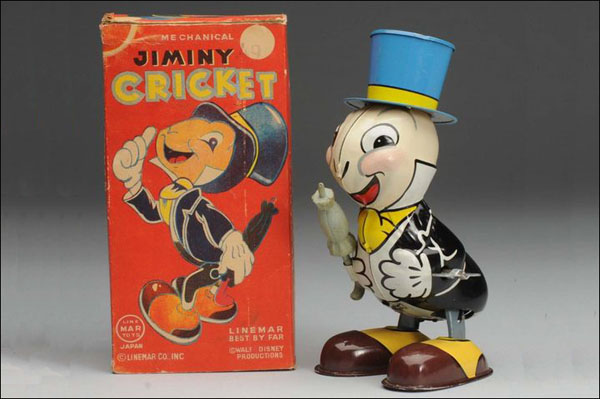
Kimball on Jiminy Cricket. In the Boston Sunday Globe July 12, 1992, animator Ward Kimball talked once again about creating Jiminy Cricket. I was once at an event where Kimball blew up when somebody asked him about creating the character since he had done it so often in the past. For this interview, Kimball was preparing for a personal appearance in Japan so he was slightly more mellow and gave some information I had never heard him share previously about designing the character.
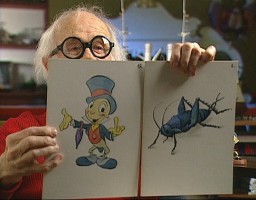 “I went back and looked at (the Silly Symphony) The Grasshopper and the Ant which we had done and I couldn’t just copy it because Walt would, of course, spot that right away, even though we might darken him. We couldn’t make him black like a real cricket or dark black because maybe it would be seen as a racist slur.
“I went back and looked at (the Silly Symphony) The Grasshopper and the Ant which we had done and I couldn’t just copy it because Walt would, of course, spot that right away, even though we might darken him. We couldn’t make him black like a real cricket or dark black because maybe it would be seen as a racist slur.
“So I kept going back to Walt with different designs, starting to eliminate anything that looked like an insect. Walt kept saying, ‘Kimball, he’s going to be through the whole picture. He’s not friendly-looking’.
“And I learned a lesson: Everyone loves animals for the most part but nobody likes an insect. I don’t care whether it’s a spider, a silverfish or what – you just stomp on them. They’re just ugly. Walt realized that so I finally kept stripping the character of anything resembling an insect and ended up with a little guy roughly two inches high. I took some artistic license there. He’s just a little man. He was a cricket not because he looked like one but because we called him a cricket.”
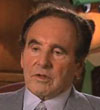 We Can Clone Joe Barbera. In May 1992, Turner Home Entertainment announced an agreement with Art Guard Corporation to implement an anti-forgery authentication into all its animation art. The process locked animation producer Joe Barbera’s DNA into every piece of animation art sold so that it could be verified as genuine. “When the studio asked how much I’d help with protecting the integrity of our animation art, I said ‘I’d give my right hand’. They took me literally. I’ve put time and toil into cartoons most of my life. Now they want my blood as well,” joked Barbera.
We Can Clone Joe Barbera. In May 1992, Turner Home Entertainment announced an agreement with Art Guard Corporation to implement an anti-forgery authentication into all its animation art. The process locked animation producer Joe Barbera’s DNA into every piece of animation art sold so that it could be verified as genuine. “When the studio asked how much I’d help with protecting the integrity of our animation art, I said ‘I’d give my right hand’. They took me literally. I’ve put time and toil into cartoons most of my life. Now they want my blood as well,” joked Barbera.
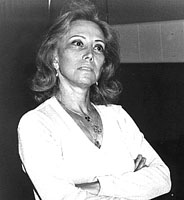
June
June Foray and Chuck Jones. In an interview with June Foray by Shel Dorf in Comics Buyer’s Guide #323 (January 25, 1980), she said: “I did a lot of things for Chuck Jones. Chuck is quite an intellectual. And, it is always a pleasure working with him, because he has nuances and sensitivity that I don’t think you’d find on the Saturday morning shows.
I played Megera the snake (in Rikki-Tikki-Tavi) and I also did the very British young mother in it. I also played the mother in White Seal and the mother in Mowgli’s Brothers. At the same time I was doing commercials as well like Brunhilde in the Captain Crunch commercials for Jay Ward. In this business, you do a lot of different things at the same time just to make a living.
“For Chuck, I did The Curiosity Shop where I did an aardvark. They didn’t know what kind of voice to use in that so I figured out with such a long nose it would be a very nasal sounding voice.”
 The Girl in the Red Truck. In an interview with comics historian Rick Marshall published in Nemo magazine #31, cartoonist Charles Schulz talked about the television movie The Girl in the Red Truck that aired September 27, 1988.
The Girl in the Red Truck. In an interview with comics historian Rick Marshall published in Nemo magazine #31, cartoonist Charles Schulz talked about the television movie The Girl in the Red Truck that aired September 27, 1988.
Schulz had stated “I wanted this to be my Citizen Kane but it’s not.” Schulz’s son, Monte helped write the script. It was conceived four years before Who Framed Roger Rabbit but by the time it was completed that ground-breaking film had been released and the film suffered in comparison.
“My (twenty-nine year old) daughter Jill is a professional skater with the Ice Follies, Holiday on Ice, and she starring in my new venture, a new movie called The Girl in the Red Truck. It’s an idea I got one day where Spike (Snoopy’s brother who lives in the desert) sees somebody drive by in a red truck and he waves to this girl and the girl waves back and he thinks ‘Wow! That was great’.
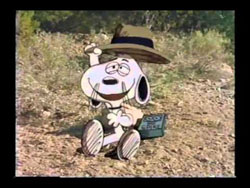 “So he waits for her to come back and I thought to myself as I was drawing these strips, ‘This is too big for a comic strip. A comic strip really can’t carry a story like this. It would make a good television show’. Then I thought, ‘It would make a great movie.’ (Laughter) Finally, after fiddling around with it, for, oh, almost two years, I settled for an hour television movie, 47 minute, and I’m paying for the whole thing myself. We went down to Arizona last November and filmed the whole thing with Spike and Jill meeting on the desert and his happiness is destroyed because she has a boyfriend. (Laughter)
“So he waits for her to come back and I thought to myself as I was drawing these strips, ‘This is too big for a comic strip. A comic strip really can’t carry a story like this. It would make a good television show’. Then I thought, ‘It would make a great movie.’ (Laughter) Finally, after fiddling around with it, for, oh, almost two years, I settled for an hour television movie, 47 minute, and I’m paying for the whole thing myself. We went down to Arizona last November and filmed the whole thing with Spike and Jill meeting on the desert and his happiness is destroyed because she has a boyfriend. (Laughter)
“Of course, Jill is a great skater so we have a great roller-skating sequence where Jill and Spike skate together. Now, Bill Melendez is adding Spike to the film. It’s live action and animation. Spike can’t talk and I refuse to give him a voice so in the very beginning Charlie Brown is reading Snoopy a letter he got from Spike so that explains what’s going on.”
The Only Thing We Have To Fear Is…. In 1983, Ellsworth Barthen who was a respected New York animator who began his career as an in-betweener at Famous Studios used his spare time as a Franklin Delano Roosevelt impersonator. At the time he had been doing it for roughly thirty years. He was in demand for parties and appeared at The New Deal, a restaurant in SoHo according to the NY Daily News March 3, 1983.
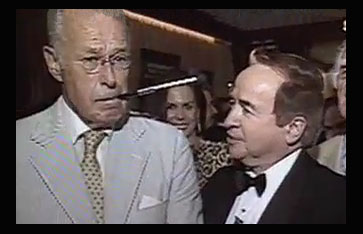
Ellsworth (left) appearing on the Joe Franklin Show as Franklin D. Roosevelt.
Caine’s Inspiration. When the movie Deathtrap (1982) based on the Ira Levin thriller opened, actor Michael Caine told the media that he had based his characterization of the washed-up playwright Sidney Bruhl on an interesting source. “I modeled him after Sylvester the cat,” said the actor.
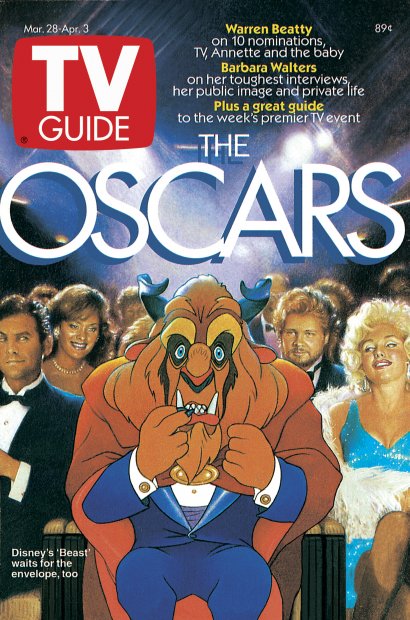
Who’s That? On the cover of TV Guide magazine for March 28, 1992 there was the Beast from Disney’s Beauty and the Beast nervously awaiting the Oscar announcements since the film was nominated that year for Best Picture. The other people on the cover were not actual celebrities but people that illustrator Chris Notarile chose as models, among them his wife, his cousin and himself (in the beard).


 Jim Korkis is an internationally respected animation historian who in recent years has devoted his attention to the many worlds of Disney. He was a columnist for a variety of animation magazines. With his former writing partner, John Cawley, he authored several animation related books including The Encyclopedia of Cartoon Superstars, How to Create Animation, Cartoon Confidential and Get Animated’s Animation Art Buyer’s Guide. He taught animation classes at the Disney Institute in Florida as well as instructing classes on acting and animation history for Disney Feature Animation: Florida.
Jim Korkis is an internationally respected animation historian who in recent years has devoted his attention to the many worlds of Disney. He was a columnist for a variety of animation magazines. With his former writing partner, John Cawley, he authored several animation related books including The Encyclopedia of Cartoon Superstars, How to Create Animation, Cartoon Confidential and Get Animated’s Animation Art Buyer’s Guide. He taught animation classes at the Disney Institute in Florida as well as instructing classes on acting and animation history for Disney Feature Animation: Florida.




















































The Girl in the Red Truck was the only Peanuts special that was a Roger Rabbit type hybrid (which both came out in 1988) and it sadly bombed. Guess everyone was so used to seeing the animated Peanuts specials they weren’t expecting a live action/animated special about Spike and the young woman he met in the middle of the Mojave Desert. Since it’s initial showing, The Girl in the Red Truck was never broadcast on national television again.
It was an interesting experiment to say the least. The animation of Spike reminded me more of those types of commercials Melendez would do where Peanuts characters are placed in a live-action setting, like the ones for MetLife in the 90’s.
The special did get a VHS release so it wasn’t a total loss if anyone cares to track down a copy to see Schulz’s magnum opus. 😉
Barthen was with the Fleischers before he worked at Famous. He became Johnny Gent’s assistant after Jack Ozark left Famous to run his own studio. (Ozark was Gent’s assistant prior to Barthen)
EVERYONE was with the Fleischers before they worked at Famous. After all, it was the exact same studio, only stolen.
“The process locked animation producer Joe Barbera’s DNA into every piece of animation art sold so that it could be verified as genuine.”
…That’s creepy.
I’m sure at that time, it was the wave of the future and they were being very forward-thinking in that respect. I guess a simple signature on the cel wasn’t enough.